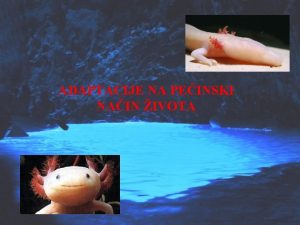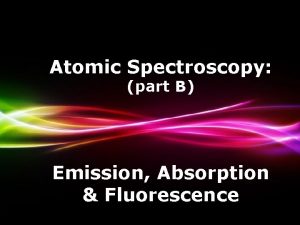Aplication of fluorescence spectroscopy in Astyanax altiparanae scales

- Slides: 1

Aplication of fluorescence spectroscopy in Astyanax altiparanae scales for differentiation of populations. Realização: Organização: Apoio: LIMA, D. M. V. ; ALMEIDA, F. S. A. ; SANTANA, C. A. . Programa de Pós-graduação em Recursos Naturais, Universidade Estadual de Mato Grosso do Sul – UEMS, C. P. 351, 79804 -970, Dourados, MS, Brazil. Introduction Astyanax altiparanae (Figure 1) belongs to the subfamily Tetragonopterinae, which in the most diverse and largely distributed of Characidae. These fish have a small size, whose total length reach up to 150 mm, and its diet revels a specie generalist and opportunist, which is highly adaptable to the physical environment changes with elevated plasticity in response to resource availability. It is the most common fish found in Upper Paraná river, occupying diferente types and sizes of environments (streams, lakes and rivers) (SÚAREZ et al. , 2011). Statistical analysis The existence of some inter-population difference was verified using a discriminant function analysis, in wich the selected spectral peak intensities were used as variables. This is a highly efficient method and is used to find a linear combination of variables that best explain the differentiation between analyzed populations. The geographical distance was obtained through of cartographic base (1: 1000000) and the distance between sites was measured using the river flow. The environmental descriptors, after standardizations (mean=0 and standard deviation=1) were used to produce a matrix of environmental distance among habitats using a Euclidean distance method. The partial Mantel test was used to quantify the influence of limnology and geographical distance on populations differentiation. explaining 80. 3% of the data variation (figure 6). For the external face, Wilk's Lambda = 0. 073; F=15. 35; p <0. 001 were obtained, with the first canonical root explaining 76. 1% of the data variation. Results and Discussion Figure 1. Astyanax altiparanae Despite of greater application of spectroscopy techniques in many biological compounds (CHENG et al. , 2013), the objective of this study is to analyze if Astyanax altiparanae scales exhibit fluorescence behavior to differentiate the chemical composition of the scale of different populations. Figure 3 below show the emission spectrum under excitation at =360 nm. This spectrum can be decomposed in four peaks. The hydroxiapatite appear at 18000 and 24500 cm-1, and the collagen at 20500 and 23000 cm-1 (Figure 3). Figure 5. Scatterplot of scales fluorescence spectroscopy, excitation at =360 nm, internal face. Methodology Collection The fish were sampled in ten streams from the Ivinhema river Basin, Upper Paraná river, Brazil (Figure 2). Figure 6. Scatterplot of scales fluorescence spectroscopy, excitation at =405 nm, internal face. Figure 3. Fluorescence under excitation at =360 nm of scale A. altiparanae. The excitation spectrum at =405 nm show three peaks. The hydroxiapatite appear at 18000 cm-1, and the collagen at 20100 and 22500 cm-1(Figure 4). The result of the Mahalanobis distance using the limnological data streams and data from fluorescence analysis proved to be not significant for the differentiation of populations (r = 0. 06; p = ns). The results using the geographical distance data together with the data of the fluorescence analysis is also shown no significant (r = 0. 23; p = ns). These results indicate that the fluorescence has potential to find differences between populations through the statistics. Conclusion Figure 2. Map of Ivinhema river basin, Upper Paraná basin with location of sampled streams. The results indicate that although each face of the scale has a different chemical composition, it was not observed strong difference in the luminescence curve shapes, and both excitation wavelengths are capable to analyze the scales A. altiparanae, providing meaningful and enlightening results for the differentiation of populations. Immediately after being collected, the fish were fixed in 10% formaldehyde to be transfer to the laboratory, where they were transfered to bottles containing 70% alcohol. From each stream, with five to ten portion of each fish. After the scales were dried in vacum for at least 12 hours to remove the moisture. For each stream portion a set of environmental descriptors were obtained. Fluorescence were perfomed at two excitation wavelengths: 360 e 405 nm. For 360 nm was used Ar+ laser using a Coherente Innova 308 C and 405 nm was a diode laser. A bifurcated optical fiber was used to conduct the excitation light and capture the emission signal of the sample and lead it to the portable Ocean Optics HR 4000 spectrometer, where the fluorescence spectrum was detected and stored in a microcomputer. After analysis, a deconvolution process was made to find that the best adjusted Gaussian spectrum. The intensities of these data were collected to build the statistical matrix. References Figure 4. Fluorescence with excitation at =405 nm of scale A. altiparanae. The discriminant analysis demonstrated a significantly differentiation among analyzed populations. Under excitation at =360 nm, in the internal face, the statistical analysis provided a Wilk’s Lambda = 0. 145; F= 10. 66; p < 0. 001. The first root explain 71% data variation (Figure 5). The external face provided Wilk's Lambda = 0. 143; F = 10. 77; p <0. 001, exhibiting a result similar to the internal dispersion. The first canonical root explained 74. 5% of the data variation. For excitation in =405 nm, the internal face provided Wilk's Lambda = 0. 106; F= 13. 54; p < 0. 001, showing significant difference between the streams, with the first canonical root SÚAREZ, Y. R. , SOUZA, M. M. , FERREIRA, F. S. , PEREIRA, M. J. , SILVA, E. A. , XIMENES, L. Q. L. , AZEVEDO, L. G. , MARTINS, O. C. , LIMA-JUNIOR, S. E. Patterns of species richness and composition of fish assemblages in streams of the Ivinhema River basin, Upper Paraná River. Acta Limnologia Brasiliensia, v. 23, n. 2, p. 177 -188, 2011. CHENG, J. ; DAI, Q. ; SUN, D. ; ZENG, X. ; LIU, D. ; PU, H. Appçications of non-destructive spectroscopy techniques for fish quality and safety evaluation and inpection. Trends in Food Science & Technology, v. 34. p. 18 -31, 2013. Acknowledgments

